The Importance of Tractor Tire Boots in Agriculture


Intro
In the fast-paced world of agriculture, every component of machinery plays a crucial role in ensuring smooth operations. One such often-overlooked component is the tractor tire boot. Used primarily as an emergency solution for punctured tires, these boots are invaluable in keeping farmers moving during critical times. Understanding the significance of tire boots is not just about maintenance; it’s about enhancing the efficiency of agricultural practices while minimizing downtime.
Farmers experience unique challenges when it comes to machinery. A flat tire can quickly escalate into a major obstacle, halting progress and productivity. Tractor tire boots emerge as vital tools that ensure this does not become a reality. They serve multiple purposes, from extending the life of tires to providing a quick fix in various terrains. With advancements in technology and materials, their effectiveness has only increased over time, providing solutions that are tailored to the demanding needs of modern agriculture.
The evolving landscape of farming also means that understanding how tire boots work can empower both novice and experienced farmers. In this exploration, we'll dissect their functionality, advantages, and the practical steps to installation. Through rich examples and a grounded understanding of how these tools enhance agricultural practices, we aim to equip you with knowledge that can translate to tangible benefits in the field.
Preface to Tractor Tire Boots
The world of agriculture has always been one of adaptation and innovation. As challenges evolve—from soil conditions to climate shifts—farmers continually seek out tools that can provide a competitive edge. One such tool, which may not always be at the forefront of discussions yet plays a significant role, is the tractor tire boot. These boots, although a seemingly minor accessory, are indispensable for ensuring both the longevity of tractor tires and the overall efficiency of farming operations.
What are Tractor Tire Boots?
Tractor tire boots are specialized inserts designed to protect and enhance the performance of tractor tires. Made from durable materials, these boots fit inside a tire to support its structure and deliver added traction. Essentially, they act as a safeguard against punctures, abrasions, and other forms of damage that can occur while navigating rough terrains frequently found on farmland.
By preventing direct wear and tear to the tire, these boots not only prolong the tire's lifespan but also reduce the frequency of replacements, offering a more cost-effective approach to tire maintenance.
Importance in Agriculture
The significance of tractor tire boots in agriculture cannot be overstated. With farming being a labor-intensive endeavor, equipment reliability is paramount. When farmers invest in quality tires, they expect those tires to perform under the most trying conditions—be it muddy fields, rocky paths, or uneven ground. In these scenarios, tire boots prove their worth by providing enhanced traction and stability.
In addition to performance, there’s a crucial economic aspect to consider. Over time, investing in tractor tire boots can lead to significant savings in repairs and replacements. It’s like putting up a solid fence — it keeps the critters out and ultimately protects your investment. Moreover, as sustainability becomes a growing concern in agriculture, prolonged tire life through the use of boots fits squarely into the narrative of reducing waste and environmental impact.
Therefore, tractor tire boots stand as a testament to how even small innovations can create substantial improvements in agricultural practices, marrying efficiency with responsible farming.
Functionality of Tractor Tire Boots
Understanding the functionality of tractor tire boots reveals much about their integral role within agricultural machinery. These boots not only provide essential support to tires but serve several practical functions that enable farmers to maximize their equipment performance. In an era where efficiency is everything, recognizing these functionalities can ultimately guide farmers in making informed decisions for their operations.
How They Work
At their core, tractor tire boots work as protective inserts that enhance the structural integrity of the tires. They fit snugly inside the tire, acting as a shield against punctures and damage that might otherwise lead to costly downtime. When a tire is inflated, the boot takes on the shape of the inner cavity, distributing the air pressure evenly across the surface of the tire. This alleviation of stress not only extends tire life but also helps maintain proper traction.
Additionally, some models of tire boots can assist in adjusting the tire's shape to better suit varying conditions in the field, such as increasing traction in muddy conditions or adapting to rocky terrains. The materials used in constructing these boots are meticulously chosen for their impact resistance and flexibility. Hence, they possess the adaptable capacity to cater effectively to different agricultural settings.
Applications in Farming
The applications of tractor tire boots in farming are as diverse as the crops they help cultivate. Here are a few specific areas where tire boots prove invaluable:
- Soil Conservation: The enhanced traction offered by boots reduces soil compaction, a critical factor in maintaining soil health and improving crop yields.
- Crop Protection: By providing better traction and stability, tire boots mitigate the wheel slip, which can otherwise lead to significant crop damage.
- Versatility in Terrain: Tire boots enable tractors to perform efficiently across various landscapes, from muddy fields to uneven terrains. This versatility enhances the operational agility of farming equipment.
"Selecting the right tractor tire boots enriches agricultural productivity and allows for smoother operations across different farming contexts."
Additionally, many farmers have found that using tire boots results in improved fuel efficiency. A tractor that operates with less slipping and better grip requires less energy to perform the same tasks, thereby lowering fuel costs. This becomes particularly pertinent given the rising fuel prices that many regions are currently facing.
In summary, the functionality of tractor tire boots is multidimensional; they serve as crucial components in ensuring that agricultural operations run smoothly. From improving traction to extending tire life, the benefits derived from such implements cannot be understated.
Material Considerations
When it comes to tractor tire boots, the materials used can make or break their effectiveness and longevity. Selecting the right material not only affects performance but also influences the overall cost and maintenance of the boots. In the world of modern farming, where efficiency is the name of the game, understanding material considerations stands as a pillar of smart agricultural practices.
Types of Materials Used
Tractor tire boots are primarily made from a few distinct materials that cater to different needs in agricultural settings. Two of the most commonly used materials are:
- Vulcanized Rubber: This material has stood the test of time due to its excellent flexibility and resistant properties. It can stretch without tearing and withstands various weather conditions. Its ability to resist punctures makes it a preferred choice for many farmers dealing with rocky or uneven terrains.
- Polyurethane: Known for its lightweight yet incredibly strong characteristics, polyurethane is increasingly popular in making tire boots. Its chemical resistance is particularly beneficial as it can endure exposure to oils and fuels that can degrade other materials.
Each material has its own strengths and weaknesses, making it paramount to assess the specific requirements of your farming operation before making a selection.
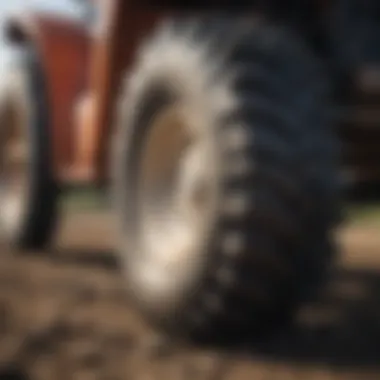
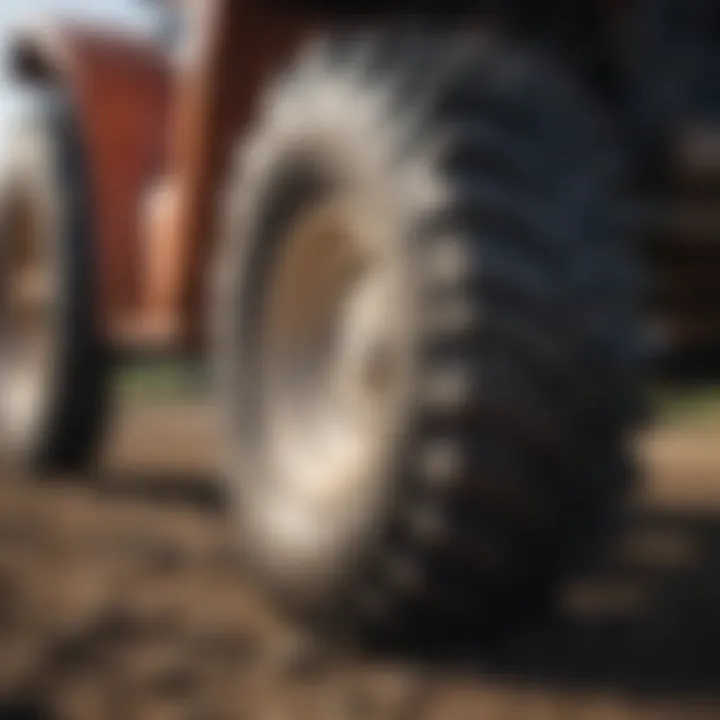
Durability and Longevity
Durability and longevity are crucial when evaluating tractor tire boots. A farmer's livelihood depends significantly on the equipment’s performance and reliability. With the right material, tire boots can last for several seasons, even under heavy use. Typical lifespan expectancy varies based on factors like:
- Operating Environment: Boots used in abrasive conditions, such as rocky fields, may wear out quicker than those used on smooth surfaces.
- Maintenance Practices: Regular inspections and prompt repairs can significantly extend the life of tire boots. Keeping them clean and checking for punctures will help in maintaining their resilience.
Durable materials can save farmers money in the long run, reducing the frequency of replacements and allowing for prolonged operation without hiccups.
Cost-Effectiveness
Cost-effectiveness is a frequent touchstone in discussions about agricultural supplies. While the initial investment in high-quality tractor tire boots might seem daunting, this expense should be viewed through the lens of long-term gains. The benefits include:
- Reduced Repairs: Quality materials reduce the chances of significant failures. Fewer emergencies mean lower repair costs down the road.
- Enhanced Performance: Well-constructed tire boots contribute positively to traction and overall vehicle performance, resulting in better fuel efficiency. When tractors run better, farmers save time and money.
Incorporating the right material into your farming practices is not merely a choice; it's a commitment to enhancing productivity and sustainability. Proper consideration of materials ensures that farmers can handle whatever nature, terrain, or task throws at them.
Compatibility with Tractor Models
When it comes to integrating tractor tire boots, understanding compatibility with various tractor models is paramount. This consideration ensures that the boot fits correctly and functions effectively, optimizing performance on the field. Moreover, an ill-fitting tire boot can do more harm than good, leading to safety concerns and reduced efficiency. Hence, farmers must be keenly aware of their specific tractor model's requirements.
Assessing Tire Size
Assessing tire size is the first step in ensuring the right fit and function of tractor tire boots. Tractor tires come in different sizes and specifications, which can vary significantly based on the model and brand. With such a broad range of sizes, it’s essential to measure the tire's diameter and width accurately. The most common sizes can usually be found on the sidewall of the tire, often indicated in a format like 480/80R42.
Farmers should also be aware of the aspect ratio and load index, as these factors play critical roles in determining the appropriate boot. Not all tire boots are created equal, and selecting a boot designed specifically for the assessed size will not only enhance performance but could also extend the life of both the tires and the boots themselves.
Brand-Specific Guidelines
Different manufacturers may have unique recommendations regarding tire boots for their tractors. This means following brand-specific guidelines is essential when selecting the right tire boots. Each brand, be it John Deere, Case IH, or New Holland, typically designs their tractors with particular dimensions and specifications in mind.
When shopping for tire boots, it's beneficial to consult the manufacturer’s manual or website, which often provides detailed specs for different models. Additionally, many brand websites include compatibility charts or guides that can help farmers match their tractor model with the right tire boot type.
- Here are some points to consider:
- Always check the model year, as specifications could vary.
- Some brands offer exclusive tire boot options that integrate better with their designs.
- Look out for any feedback from other farmers or operators who have experience with similar models.
"Choosing the right tire boot can mean the difference between a hard day's work and one full of complications."
In summary, ensuring proper compatibility with tractor models is not just a matter of fitting a product; it can transform the performance of your equipment. By diligently assessing tire sizes and adhering to brand-specific guidelines, farmers can enjoy enhanced safety, efficiency, and longevity in their agricultural practices.
Installation of Tire Boots
Installing tire boots on tractors is a pivotal aspect that greatly affects overall farming efficiency. Proper installation ensures optimum performance, longevity of the boots, and prevents potential mishaps in the fields. Getting it right isn’t just about following a set of steps; it’s about understanding the nuances of tire boots and how they integrate with the larger machinery of agriculture. When the rubber meets the road—literally speaking—proper installation can make or break a task at hand.
Step-by-Step Guide
- Preparation
Before you dive into the installation, gather all necessary tools and materials. This should include the tire boots, a valve tool, tire levers, and possibly a pressure gauge to assess inflation levels. Preparation is half the battle; you'll thank yourself later for not running back to the shed for a missing tool. - Deflate the Tire
Begin by deflating the tire completely to eliminate any air pressure. This step is crucial as it allows for an easier installation and fits the tire boot snugly. - Remove the Tire
Using the tire levers, carefully remove the tire from the rim. This step requires a bit of technique — too much force can damage the tire or rim. - Inspect the Inner Tube and Rim
Check for any signs of wear, cracks, or punctures. If the inner tube shows signs of damage, it might need repair or replacement before proceeding. - Placing the Tire Boot
Position the tire boot inside the tire. Aim for a centered placement to promote balanced weight distribution when the tire is inflated. - Reattach the Tire
Slide the tire back onto the rim carefully. Ensure the tire boot comfortably sits within the tire as you fit it back in. - Inflation
Slowly inflate the tire, keeping an eye on the boot to ensure it moves into position properly. Use a pressure gauge to achieve the recommended PSI for the specific tire. - Final Checks
Once inflated, do a final inspection to make sure everything looks good. Check for any deformities or outlines that may indicate improper placement of the boot.
Following these steps not only brings peace of mind but also enhances the efficiency of your farming operations.
Common Installation Mistakes
Even seasoned farmers can stumble when it comes to tire boot installation. Here are common pitfalls to watch out for:
- Neglecting Tire Condition
Failing to inspect the tire for wear and damage could lead to further complications. Even the best tire boot won’t work wonders on a worn-out tire. - Skipping the Deflation Step
Attempting to install while the tire is still inflated makes the task far more difficult and can lead to uneven fitting. - Improper Inflating Techniques
Lighting quick inflation without monitoring the pressure is a surefire way to throw things off. It’s important to gradually inflate to avoid bulging or other aberrations. - Ignoring Manufacturer Instructions
Each tire boot may come with specific installation guidelines unique to its design. Overlooking these details can compromise the performance. - Rushing the Process
Hustling through the installation may save time initially but often results in mistakes that require redoing the work later.
Taking care in the installation process can save significant time and resources in the long run, often leading to better traction, reduced fuel consumption, and a smoother ride in the field.
Maintenance Tips
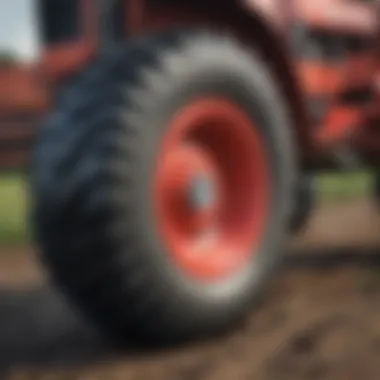
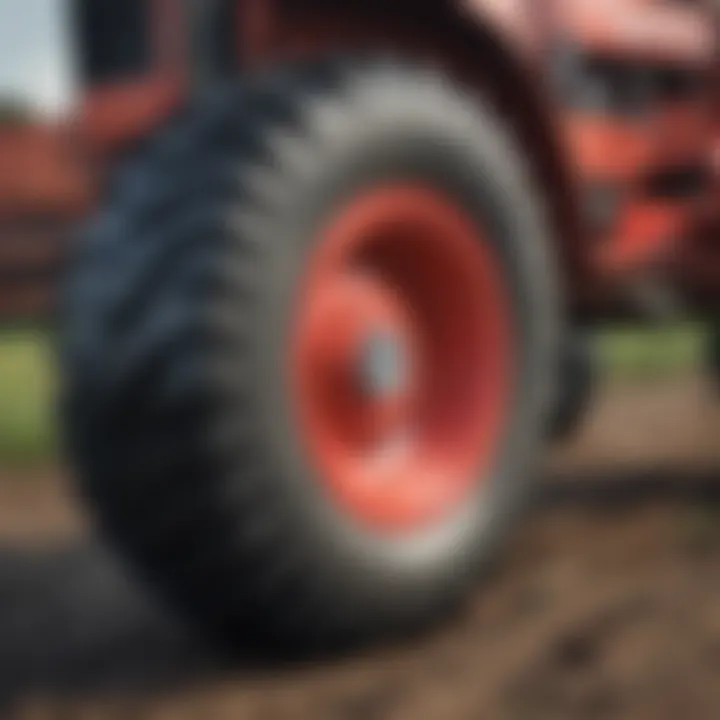
Maintaining tractor tire boots is a crucial aspect to getting the best out of them in agriculture. Just like a well-tuned engine can make a world of difference in performance, regular checks and repairs on tire boots ensure that they function optimally and extend their lifespan. Farmers who stay on top of maintenance not only protect their investment but also enhance the overall efficiency of their farming operations.
Routine Inspections
Routine inspections play a pivotal role in tire boot maintenance. Regular checks can help catch issues before they escalate into larger problems, much like catching the first signs of rust on farm machinery. During these inspections, farmers should focus on multiple factors.
For instance, checking for air loss is critical. A small puncture might go unnoticed, leading to major operational challenges. Visual examinations should cover the boot’s overall structure for cracks or signs of wear.
Also, keeping an eye on how the boot aligns with the tire itself can save trouble in the long run. Misalignment can lead to uneven pressure, affecting the tire's grip and causing premature wear. A checklist can be advantageous here:
- Visual Inspection: Check for cracks or abnormalities.
- Air Pressure Measurement: Ensure that the boot maintains correct pressure.
- Alignments Checks: Confirm that the boot sits correctly with the tire.
Implementing such checks regularly can be a game changer, as proactive maintenance avoids last-minute repairs and keeps the farm running smoothly.
Repair Techniques
When it comes to repair techniques, knowledge is power. Unlike some other agricultural equipment, tire boots are relatively straightforward to fix, given the right approach. Minor tears or punctures can frequently be patched up with specialized tire repair kits that are available in the market. Most kits come equipped with everything needed, making it simple for a farmer to take on their own repairs. Here’s a brief rundown on how to tackle common issues:
- Identify the Problem: Pinpoint the location and size of the damage.
- Clean the Area: Before applying any patch or sealant, ensure the surface is clean and dry.
- Patch it Up: Use the materials from the repair kit to seal the puncture followed by pressing firmly to ensure adherence.
- Recheck Alignment: After the repair, check to ensure the boot aligns well with the tire again to prevent future mishaps.
Maintaining and repairing tire boots not only saves money but also boosts efficiency on the farm.
Ultimately, routine inspections and proper repair techniques act as the backbone of tire boot maintenance. By understanding these methods, farmers can easily safeguard their equipment, ensuring that their machines are always ready to hit the field when needed.
Advantages of Using Tire Boots
The utilization of tractor tire boots is a game changer in agricultural practices, offering a cornucopia of benefits that can greatly affect productivity and efficiency. This section will delve into the significant advantages that come with using tire boots, particularly focusing on how they enhance traction, reduce tire wear, and lead to improved fuel efficiency. For farmers, understanding these benefits is essential as it may influence choices regarding equipment maintenance and operational practices.
Enhanced Traction
One of the standout features of tractor tire boots is the way they bolster traction. When tackling uneven terrains or slippery surfaces, having the right grip is paramount. Tire boots provide added support and can engage the soil more effectively than traditional tire designs. The enhanced traction not only translates to better control of the vehicle but also minimizes the risk of getting stuck in muddy conditions. Farmers may notice a marked improvement in their ability to maneuver on slopes, enhancing both safety and operational efficiency.
Notably, tire boots can also reduce soil compaction, an issue that plagues many agricultural settings. With better traction, farmers can move through fields with less pressure on the land, preserving the quality of the soil over time. This balance of traction and soil health is essential for sustainable farming practices.
Reduced Tire Wear
Another compelling reason to consider tire boots is their ability to decrease tire wear and tear. Farming involves a variety of challenging terrains, which can quickly degrade standard tractor tires. Introducing tire boots can cushion impact and distribute the stresses across a broader area. This reduces friction with rough surfaces and can prolong the life of the tires significantly.
For farmers, this means spending less on tire replacements—a cost that can add up over time, impacting the overall budget for agricultural operations. Those who have integrated tire boots into their machinery often report that they extend the intervals between tire changeouts, which is a boon for maintaining operational effectiveness without frequent interruptions.
Improved Fuel Efficiency
Fuel costs can be a hefty expenditure for farmers, and optimized fuel efficiency is thus a prime concern. Tire boots contribute to this by ensuring that the tires maintain optimal contact with the ground and effectively manage the load carried by the tractor. When traction is consistent, engines don’t have to work as hard to propel the vehicle forward, which naturally leads to reduced fuel consumption.
Many farmers notice that after implementing tractor tire boots, their fuel efficiency improves noticeably. Some report savings that can be measured in hundreds of dollars annually, contributing positively to their bottom line.
By investing in tire boots, farmers not only protect their equipment but also bolster their operational efficiency, paving the way for sustainable agricultural practices.
Technological Advancements in Tire Boots
In the ever-evolving field of agriculture, technological advancements play a pivotal role in ensuring efficiency and productivity. This holds true for tractor tire boots as well. The incorporation of innovative technologies is not just a trend, it’s a necessity. As farming demands grow and challenges mount, the capability of tire boots to adapt through advances in materials and technology can mean the difference between a smooth operation and unnecessary setbacks. In this section, we will explore both innovative materials and smart tire technologies that mark significant strides in the realm of tractor tire boots.
Innovative Materials
Modern advancements in materials science have transformed the manufacturing of tractor tire boots, making them more effective than their predecessors. Traditional materials have often fallen short in terms of durability and performance, which led to the push for innovative alternatives.
- Synthetic Rubber: This material provides superior resistance against punctures and abrasions compared to natural rubber. It not only enhances the lifespan of the tire boot but also helps it maintain structural integrity under significant stress.
- Reinforced Fabrics: The introduction of reinforced fabrics has brought about significant improvements in tire flexibility and resilience. For instance, some boots utilize high-tenacity polyester blends that offer better wear resistance, prolonging the life of the product.
- Thermoplastic Elastomers (TPE): TPE composites represent another noteworthy advancement. They are versatile and can perform well across varying temperatures, crucial for farms operating in diverse climates. This adaptability supports farmers in maintaining operational efficiency regardless of local conditions.
The shift toward such innovative materials not only showcases the manufacturers' drive for enhanced performance but also reflects a growing awareness among farmers about the long-term value associated with investing slightly more upfront for products that last.
Smart Tire Technologies
The era of smart technology has also made its way to the world of tractor tire boots. The integration of sensors and connected technologies into these components is revolutionizing farming practices.
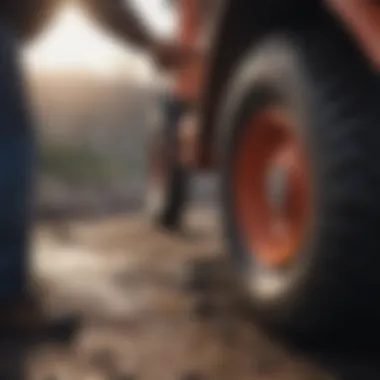

- Pressure Monitoring Systems: These systems alert farmers when tire pressure deviates from optimal levels. Maintaining proper tire pressure is critical for maximizing traction and fuel efficiency; hence, these smart solutions help in extending the lifespan of both tires and tire boots.
- Data Analytics: Advanced analytics can predict tire wear based on real-time data from the field. By being able to anticipate when a tire boot might fail, farmers can schedule maintenance more effectively, which minimizes downtime during crucial planting or harvesting periods.
- Integration with GPS Technology: Smart tire technologies can now interact with other farm management systems. For instance, tire data can be synchronized with GPS readings to provide insights on load management and overall tractor performance across different terrains.
"The proper monitoring and maintenance of tire systems can save farmers significant amounts in costs over time while also improving yields and sustainability."
These technological advancements are reshaping the landscape of agricultural equipment and operations. By embracing innovations in materials and smart technologies, farmers can enhance their productivity and operational resilience. The future of agriculture relies heavily on these advancements, making tire boots not just supplemental, but an essential component in modern farming.
Environmental Impact
Understanding the environmental impact of tractor tire boots transcends merely focusing on their functionality in agricultural settings; it dives into how these components play a significant role in sustainable farming practices. Today, in the face of climate change and resource scarcity, it’s crucial for agricultural methods to adapt and reduce unfavorable effects on the environment. Tire boots present an avenue for enhancing both farming efficiency and eco-friendliness.
As farmers embrace their use, they also contribute to broader conservation efforts. Proper installation and maintenance of tire boots minimize soil compaction and preserve the integrity of the farmland. Farmers using boots report less damage to delicate soil structures, which is vital for maintaining healthy crops. Less compaction allows better water infiltration and root development, creating a more sustainable crop growth cycle.
Moreover, adopting tire boots encourages a shift from reliance on traditional tires that might not offer the same benefits. The benefits of using tire boots do not end there; they extend into reducing overall carbon footprints by optimizing operational efficiency.
"Sustainable practices are not just about what we plant but also about how we till the land and what equipment we use."
Sustainable Practices
The sustainable practices associated with tractor tire boots lay the groundwork for environmentally conscious farming. Implementing these practices involves using technology to make informed decisions that not only enhance yield but also protect the ecosystem. Some core strategies include:
- Soil preservation: Minimizing compaction helps maintain soil health by allowing aeration and fostering biodiversity.
- Water conservation: With better soil integrity, less water is required for irrigation, ultimately saving precious resources.
- Reduced dependency on chemical interventions: Healthy soils foster natural pest controls, reducing the need for harmful pesticides.
Overall, the continued adoption of tire boots reflects a farmer's commitment to long-term sustainability, reducing the environmental impact of their operations while still achieving productive outcomes.
Recyclability of Materials
When it comes to recyclability of materials, tire boots are manufactured using various polymers and rubber compounds that can often be reprocessed or repurposed. This ability to recycle plays a vital role in ensuring minimal waste throughout their lifecycle. Some points to consider include:
- Material recovery: Many manufacturers have begun to utilize materials that are not only durable but also recyclable, reducing the environmental burden.
- Closed-loop manufacturing: This approach highlights the importance of reusing materials from old tire boots to create new ones, which significantly cuts down on landfill contributions.
- Consumer awareness: Educating users about the proper disposal of these materials is essential. When farmers recognize the recyclability of their tires, they can help move towards a more circular economy in agriculture.
In summary, the environmental impact of tractor tire boots encompasses multiple dimensions from sustainability to recyclability. The more farmers embrace these practices, the better they align with contemporary agricultural demands and environmental stewardship.
Comparative Analysis
When it comes to choosing tire solutions for tractors, a thorough comparative analysis is crucial. Understanding the differences between tire boots and traditional options can influence not only performance but also cost efficiency over time. This section aims to furnish readers with valuable insights into how these products stack up against each other and why such distinction matters in agricultural practice.
Tire Boots vs. Traditional Options
Tire boots, crafted from modern materials, provide an innovative alternative to traditional tire repair methods. Traditionally, farmers often relied on patching tires or innertubes to address punctures and other damages. While these methods can be effective, they often fall short in durability and longevity. Here are some points of consideration:
- Strength and Resilience: Tire boots are designed to withstand extreme conditions. They don’t just patch a hole; they reinforce the tire, contributing to overall durability. On the flip side, traditional patches may come loose or wear down over time.
- Easy Installation: Many tire boots are straightforward and quick to install, making them appealing for those who prefer a "get-up-and-go" solution on the farm. Traditional methods can involve intricate steps, needing special tools and skills.
- Cost Over Time: While the initial cost of tire boots may be higher, they often save money in the long run by extending the life of the tire, minimizing downtime, and reducing the frequency of repairs. Counter to this, traditional methods might seem more economical at first but can lead to more frequent repairs and tire replacements.
"Choosing the right tire solution can make or break the efficiency of farming operations."
Market Trends
Keeping an eye on market trends is equally important. The agriculture industry is continually evolving, and with it, the technology that supports it. Some noteworthy points include:
- Rising Popularity of Tire Boots: As farmers realize the advantages tire boots bring—such as enhanced traction and reduced tire wear—demand is steadily increasing. Industry reports suggest that new innovations in boot materials increase their appeal, especially among those who prioritize sustainability in farming practices.
- Technological Integration: The incorporation of smart technology within tire boots, such as sensors that monitor tire pressure, is becoming more common. This trend highlights the overall movement towards smarter farming, aligning with global demands for efficiency and sustainability.
- Competitive Landscape: As more manufacturers emerge, competition is heating up, driving prices down and enhancing product quality. Traditional tire solutions are also being re-evaluated against these new advancements.
In summary, choosing between tire boots and traditional methods is no longer just about immediate repairs; it’s about long-term benefits, sustainability, and adapting to emerging trends. Farmers need to weigh these factors carefully to optimize their equipment investments.
Epilogue
In wrapping up our exploration of tractor tire boots, it's clear their significance in agriculture cannot be overstated. These ingenious tools serve more than just one purpose; they enhance performance, prolong tire life, and contribute to more efficient fuel consumption. For farmers operating in the field, investing in tire boots means making a choice for durability and effectiveness. By understanding their multifaceted role, farmers can make informed decisions that translate into enhanced productivity and smoother operations.
Summary of Key Points
- Versatility: Tractor tire boots fit a wide range of models and conditions, making them suitable for various farm applications.
- Durable Materials: Selecting the right material for tire boots ensures longevity, reducing the frequency of replacements and thus saving costs in the long run.
- Installation and Maintenance: Proper installation and routine maintenance are crucial for maximizing the benefits of tire boots. This not only improves performance but also helps in early detection of wear and tear.
- Technological Advances: Innovations like smart tire technologies are paving the way for even greater efficiency in farming practices.
- Environmental Considerations: Many modern tire boots are designed with sustainability in mind, utilizing recyclable materials and adhering to eco-friendly practices.
Future Prospects for Tire Boots in Agriculture
The future for tractor tire boots looks promising. As the farming landscape evolves, so too do the demands placed on equipment. Anticipating these changes, manufacturers are likely to delve into research and development, pushing the bounds of materials science. New materials that provide lighter weight yet superior strength could soon hit the market, leading to improved fuel efficiency and reduced wear.
Moreover, the integration of smart technologies stands to make tire boots even more user-friendly. Imagine boots equipped with sensors that alert farmers when wear is approaching critical levels. This kind of proactive approach could mitigate downtime and allow for better planning of repairs and replacements.
In terms of sustainability, advancements in eco-friendly materials will likely lead to a wider adoption of tire boots. As growers become more environmentally conscious, the demand for products that minimize negative impacts on land could increase.



